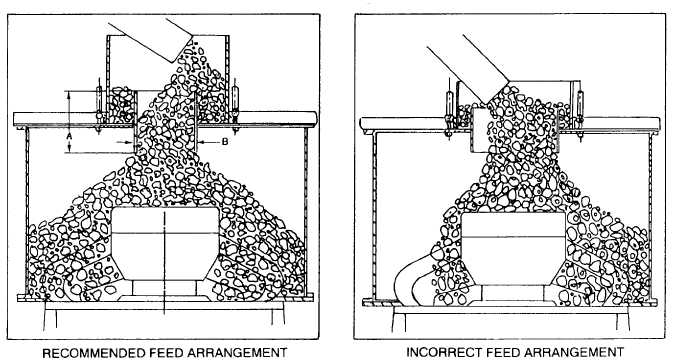excessive shock loading and may result in serious
damage to the crusher.
All hydrocone crushers are supplied with a feed
hopper with an adjustable feed spout that is adjustable
both vertically and horizontally. Horizontal adjustment
of the spout is accomplished by moving the adjustable
feed spout frame on the feed hopper. Slotted holes in the
upper flange of the feed hopper, and in the feed spout
frame, allow the feed spout to be moved horizontally in
order to position it properly over the feeder plate or
spider cap. The feed spout can be positioned vertically
by using studs and adjusting nuts to fasten the spout to
the frame. The vertical position of the spout controls the
amount of feed going into the hydrocone crusher.
Adjustable feed spout frame construction allows the
mounting of a suitable feedbox. Normally, it is better to
have the incoming feed hit the side of the feedbox, after
which it falls vertically through the feed spout. This is
the most effective way of obtaining proper feed to the
hydrocone crusher (fig. 6-8).
The discharge arrangement setup must allow the
material to discharge freely without backing up
underneath the crusher. Material backing up below and
into the hydrocone crusher can result in serious damage
to the machine.
A straight-down discharge is commonly used with
hydrocone crushers. With this arrangement, crushed
material falls into a stone box below the crusher.
Material passes through a hole in the stone box floor
onto a conveyer belt that carries it away. This discharge
arrangement helps prevent buildup of sticky materials
beneath the crusher.
The crushing chamber is annular (ring shaped).
Rock fed into the top falls between the cone and
the mantle and is crushed as the opening narrows with
the movement of the cone. When the opening widens
again, the pieces fall farther, to be crushed again
as the cone gyrates. The crushing action is similar to
that of a jaw crusher, except the squeeze comes from the
side rather than from the bottom and the curve of the
jaws.
The cone speed and the distance of travel must
be carefully synchronized. A wide space allows
pieces to fall more freely than a narrow one when the
cone is moving slowly; however, it allows pieces to fall
too far before the next impact. On the other hand, where
the space is narrow and the cone is moving rapidly,
the pieces cannot fall far enough and this causes
production to be low for the amount of power being
used.
CAUTION
DO NOT operate the cone crusher at a
smaller setting than that for which it was
designed. Operation at too small a discharge
Figure 6-8.-Recommended cone crusher feed arrangement.
6-7

